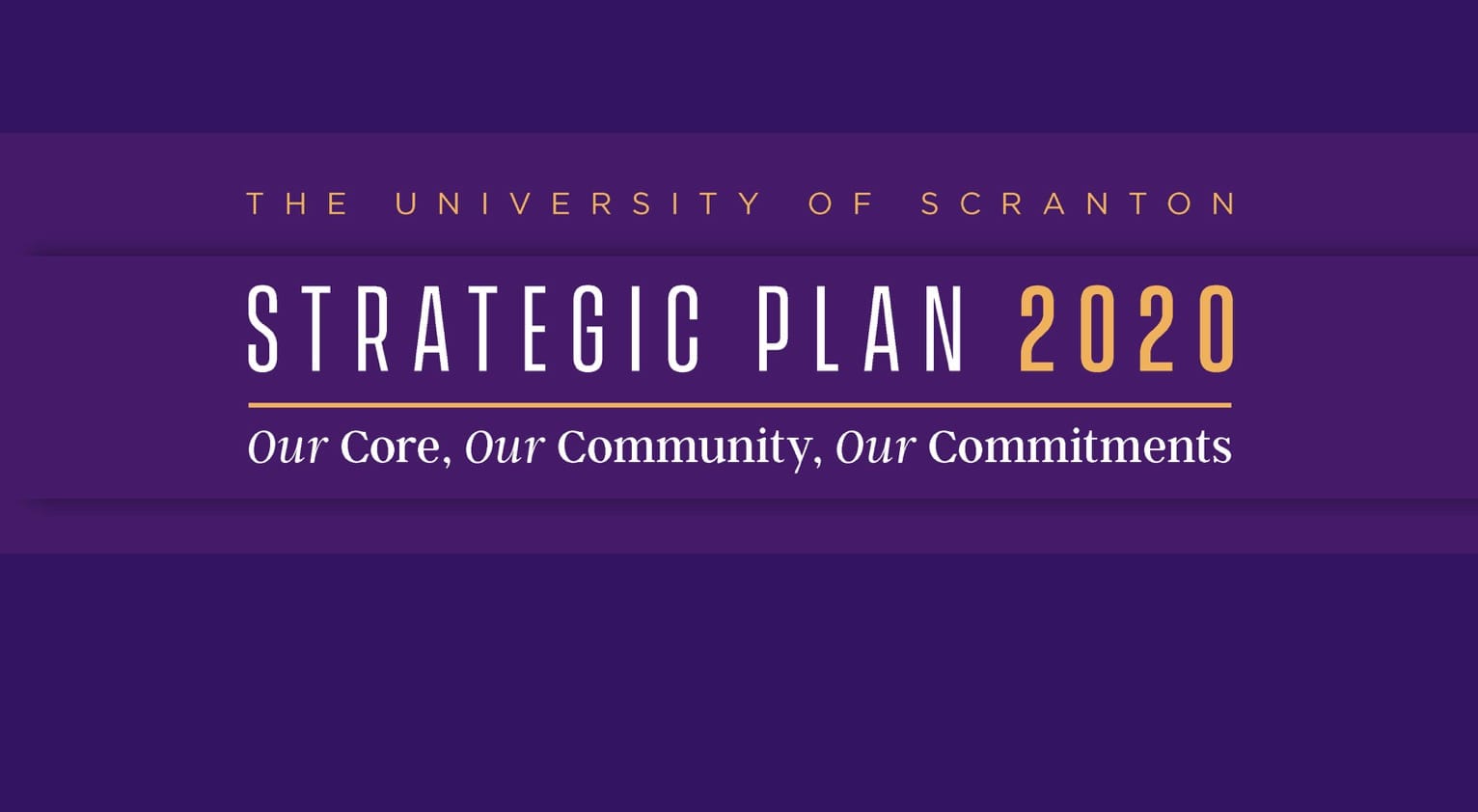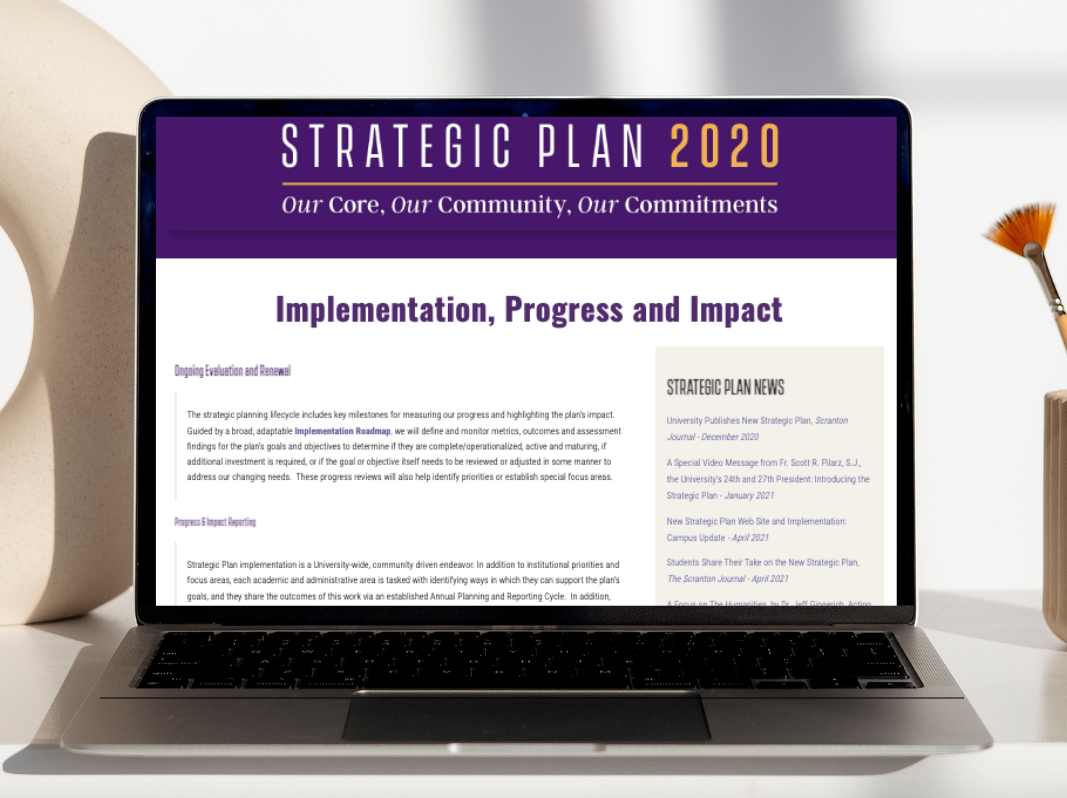University Strategic Plan: A Midpoint Check-in

Spring 2023 marks the halfway point of the University Strategic Plan. This five-year plan outlines our shared institutional goals for the Humanities: supporting students as they explore their faith, passion and purpose, advancing the University though innovation, supporting diversity, equity and inclusion and expanding partnerships in our mission. Regular progress and impact reports at the Strategic Plan website showcase initiatives and outcomes, highlighting the many ways the University community has embraced and continues to support these goals.
Regular progress and impact reports at the Strategic Plan website showcase initiatives and outcomes, highlighting the many ways the University community has embraced and continues to support these goals.
We recently chatted with Dr. Michelle Maldonado, Provost and Senior Vice President for Academic Affairs and Chair of the University Planning Committee and Kate Yerkes, Assistant Provost for Planning and Institutional Effectiveness, to discuss what has been accomplished and what is on the horizon.
Q. Kate, in your role you coordinate planning activities across the University, with particular focus on the Strategic Plan. What is a strategic plan? Why do we have one?
"In simplest terms, a strategic plan is a document defining specific goals an organization hopes to achieve over a particular span of time. The plan serves as a framework for decision making and committing to goals that address the most the important issues and needs and ultimately, as a guide for prioritizing our time and resources.
To answer why we have one, it's important to think about what not having one would mean. In the absence of shared goals, we run the risk of different areas of the University moving in very different directions. I'd also be remiss if I did not note that having institutional goals in place, and providing evidence that they are aligned with our mission and being actively pursued, is a requirement for our institutional accreditation with Middle States. So, taken together, strategic planning is a matter of best practice, good business, and of accountability."
Q: How does the strategic plan connect to the University’s Catholic, Jesuit mission?
KY: "Every college and university has a mission, some statement that defines its scope and purpose and who it serves – it’s guiding north star, if you will. This mission is the foundation for strategic goals. We do not want to embrace goals that take us far from that focal point.
Our Catholic, Jesuit mission guided our earliest conversation about the strategic plan, and it permeates it in very concrete ways. To name just a few examples:
1. The Humanities goal objectives relate to the Slattery Center for the Ignatian Humanities, and exploring connections between the Humanities and Jesuit education.
2. Jesuit ideals frame our approach to supporting students as they understand and pursue their faith, passion, and purpose.
3. Our approach to diversity, equity, and inclusion, including our commitment to cura personalis, understanding and supporting each individual in their uniqueness.
4. The Jesuit Universal Apostolic Preferences challenge us to better care for our common home and for others, and these are included in the plan’s objectives related to sustainability and service to our broader community."

Q: The Strategic Plan web page includes a lot of information about activities and outcomes. What have been some of the most significant?
Dr. Maldonado: "There have been very significant efforts to address affordability and expand our infrastructure to support student success, such as the new Opening Doors Scholarship and the restructuring of the CTLE (Center for Teaching and Learning Excellence).
The creation of an Office of Student Support and Success mirrors best practices in higher education, where student success is approached in a comprehensive manner. The Office will also have a specialist who focuses on first generation and historically underrepresented students.
In addition, the formation of the Association of Jesuit Colleges and Universities (AJCU) Conference on Student Success and Retention this year, as well as a shared commitment by all AJCU Provosts to focus on student success as a priority, mirrors the work we are doing here at the University."
KY: "There have been so many areas of impact. One that comes immediately to mind is the work we’ve done to build and now collaboratively implement the new, campus-wide plan for diversity, equity and inclusion. The work being done by staff and faculty to better understand the changing needs of our students and to support them within Student Life and other areas amazes me every day."
Q: Dr. Maldonado, as Provost, in addition to your seat on the President’s Cabinet, you are the Chair of the University Planning Committee. As you guide these groups in considering the work left to be done for this current strategic plan, what do you see as our topmost priorities?
MM: "A key priority is integrating the Strategic Plan more explicitly with the Universal Apostolic Preferences. In addition, the University Planning Committee has agreed that we need to be a key voice in championing priorities and initiatives over the next two years."
Q: What are some external trends that you find yourself thinking most about? How can our strategic planning – both the current plan and future ones – help ready us to address those opportunities and challenges?
MM: "Some of the external trends that we need to consider moving forward include: the ways in which AI (artificial intelligence) is reshaping higher education, the exploration of new academic programs that respond to shifting needs in the workplace and among our students, and a prioritized focus on student success and retention. In addition, we need to support innovative pedagogy and research through collaborative initiatives with our faculty. We address some of these elements in our current plan and newer trends will inform our future approach."
KY: "We’ll start ramping up environmental scanning within the UPC (University Planning Committee) and in other areas. Scanning is a process where we intentionally examine issues and trends to be sure we have current data and information and and try to build an understanding of what their impact could be. This analysis is key to making decisions about what needs to be part of the plan."
Q: When will we start putting pen to paper for these future plans?
KY: "Each strategic plan generally follows a five-year span, so the current one is set to conclude in spring 2025. That means that we hope to be ready to launch a new plan in fall 2025, which with the inclusive process we are committed to usually takes at least 18 months to construct. We want to be sure that all faculty, staff, and students have an opportunity to share their views as part of the planning process. The UPC is already beginning to think about the process for the next plan, and members of the campus community can expect to hear much more in spring 2024."
Q: Dr. Maldonado, you are currently co-chairing the University’s Laudato Si' process. Can you speak a bit about how this connects to our strategic plan goals? What can we expect to see in the coming months?
MM: "The Strategic Plan highlights environmental sustainability. Our new Laudato Si’ initiative will build on this emphasis and address how “care for our common home” can impact the University as a whole. This is a seven-year process, and we will be sharing our journey with the University community in the next academic year. "
Q: What would you both most hope that those reading this article understand about the Strategic Plan?
MM: "I hope that members of the University community see themselves in the Strategic Plan. We want this plan to be ours, and by that I mean a plan where each individual member of our community finds a way to connect to and embody an aspect of its vision."
KY: "That they can be involved. For some, the Strategic Plan may feel big and inaccessible – something that other people are working on that may not relate to their day-to-day life as a student or as a member of the faculty or staff. But there are ways big and small to contribute, for example, everyday steps to support inclusion, or to build connections and partnerships to support students and our broader community.
Faculty and staff can be part of their own departmental, divisional and college planning activities, helping to shape and unpack broader strategic goals in ways that are uniquely meaningful for their areas. Others may feel a connection to the spirit of the plan, for example, the advance goal is very much about innovation. Are there ways they can embrace that spirit of innovation?
Students may reflect on their experiences and how they relate to the goals of the plan in terms of what they are seeing in campus programming and services, or, if they don’t, ask why.
Student leaders may consider if there are goals or objectives in the plan they are well positioned to help with, and suggest how they can continue to be a voice for their fellow students in the planning process as we think about our goals for the future."
Check Royal News this fall for updates on projects related to the University’s Strategic Plan.






